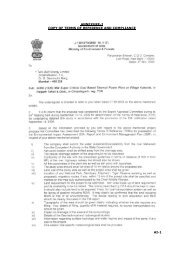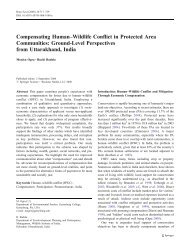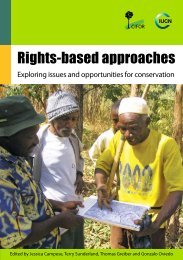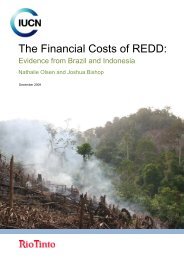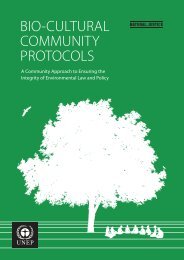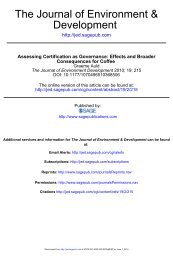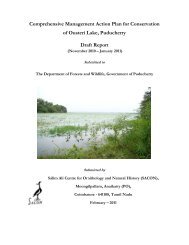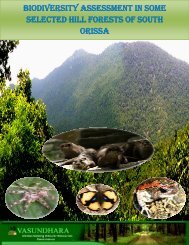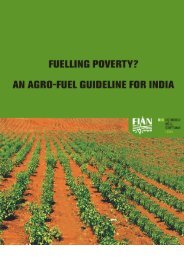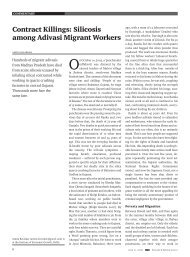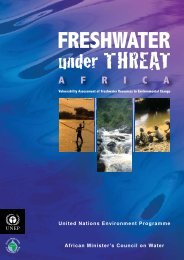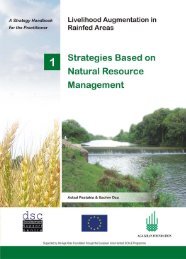Integrated River Basin Planning – Replicable ... - India Water Portal
Integrated River Basin Planning – Replicable ... - India Water Portal
Integrated River Basin Planning – Replicable ... - India Water Portal
Create successful ePaper yourself
Turn your PDF publications into a flip-book with our unique Google optimized e-Paper software.
<strong>Integrated</strong> <strong>River</strong> <strong>Basin</strong> <strong>Planning</strong>: <strong>India</strong> and the EU share experience on policy and practice<br />
IWRM Progress in Kerala’s Pamba <strong>Basin</strong><br />
Figure 10<br />
Result 1. Awarensess and political will<br />
Table 13<br />
Step/<br />
Result<br />
1. Awareness<br />
and political<br />
will<br />
The ten steps in the IWRM planning process<br />
IWRM<br />
planning<br />
process<br />
properly<br />
said<br />
Result 3.<br />
Knowledge of<br />
the situation<br />
Result 9. Capacity strengthened<br />
Result 4.<br />
Problems & challenges<br />
of WRM<br />
identified<br />
Result 5.<br />
WRM functions<br />
defined<br />
Result 6.<br />
Opportunities<br />
& constraints<br />
identified<br />
Result 7.<br />
IWRM Action<br />
Plan drafted<br />
Result 8.<br />
IWRM Action<br />
Plan adopted<br />
Result 2. Framework for participation of<br />
stakeholders<br />
Result 10.<br />
Projects<br />
portfolio and<br />
financing plan<br />
elaborated<br />
Status on the IWRM planning process for the Pamba <strong>River</strong> <strong>Basin</strong><br />
Description Present Situation Comments and suggestions for the Pamba <strong>River</strong> <strong>Basin</strong> Authority<br />
2. Framework<br />
for<br />
participation<br />
of<br />
stakeholders<br />
3. Knowledge of<br />
the situation<br />
Awareness of IWRM concept and<br />
principles relatively limited.<br />
Moderate to strong political will to<br />
bring water management into line<br />
with international best practices.<br />
Presently non-existent<br />
Data scattered between different<br />
institutions monitoring quantity and<br />
quantity.<br />
Knowledge gaps e.g. environmental<br />
flows<br />
State<br />
objectives<br />
of IWRM<br />
planning<br />
Conduct targeted awareness raising of policy-makers, water sector managers, local councils,<br />
NGOs and CBOs.<br />
Present project has through involvement of stakeholders throughout the project created<br />
increased awareness. Involving the media at several occasions created awareness to a larger<br />
group of stakeholders.<br />
Take necessary steps to establish legal and regulatory framework for stakeholder participation.<br />
Development of communication strategy to help solve problems in a participatory manner and to<br />
explore opportunities for improvements in the water sector.<br />
Stakeholder involvement has been an essential part the Pamba Pilot Project implementation.<br />
Establish common databases and information systems so that a situation analysis can be<br />
conducted based on existing data.<br />
The on-going WB funded Hydrology Project II has already assembled an integrated Hydrology<br />
Information System (HIS). This information system will eventually be upgraded to provide a<br />
comprehensive <strong>Water</strong> Information System (WIS) at the state level and national level. Pamba <strong>River</strong><br />
<strong>Basin</strong> Authority can benefit from this.<br />
Priority water related issues assessed (WRIAM) during the Pamba Pilot Project, provided<br />
essential input to a future comprehensive situation analysis. The identification of issues was<br />
carried out with full participation of stakeholders, those prioritized issues should be addressed<br />
first.<br />
Cotnd...<br />
Table 13 Status on the IWRM planning process for the Pamba <strong>River</strong> <strong>Basin</strong> (Contd...)<br />
Step/ Description Present Situation Comments and suggestions for the Pamba <strong>River</strong> <strong>Basin</strong> Authority<br />
Result<br />
4. Problems and<br />
challenges<br />
of IWRM<br />
identified<br />
Problems and challenges identified In general well known. One of the outcomes of present pilot addressed this step by assessing<br />
water related issues and management constraints.<br />
Future planning towards a full IWRM Action Plan can benefit from the data and findings of the<br />
current pilot project, especially the identified water resources issues and management issues as<br />
defined by the stakeholders.<br />
5. WRM<br />
functions<br />
defined<br />
6. Opportunities<br />
and<br />
constraints<br />
identified<br />
7. IWRM Action<br />
Plan drafted<br />
8. IWRM Action<br />
Plan adopted<br />
9. Capacity<br />
strengthened<br />
10. Projects<br />
portfolio and<br />
financing plan<br />
elaborated<br />
Present WRM functions defined,<br />
including the Pamba <strong>Basin</strong> Authority<br />
Done under present Pamba Pilot<br />
Project<br />
Pollution abatement plan exists.<br />
No IWRM plan drafted<br />
No IWRM plan adopted<br />
Ongoing capacity building but<br />
accumulation rates quite low.<br />
Continued support required for reform process within IWRM paradigm<br />
Short-term focus should be given to setting up and operationalize the Pamba <strong>River</strong> <strong>Basin</strong><br />
Authority<br />
A future situation analysis should benefit from this project output.<br />
IWRM plan to be developed as part of implementing the Roadmap<br />
Future action plan to be adopted<br />
Capacity needs assessment and capacity building at all levels required<br />
Capacity building in IWRM has been conducted as part of all sessions in present project<br />
Part of implementing the Roadmap<br />
50 51<br />
To be developed<br />
The pilot project has attempted to draw the attention of a vast group of stakeholders<br />
at different levels to IWRM. It has provided a framework for participation of a core<br />
group of actors directly and indirectly involved with water matters. <strong>River</strong> basin<br />
stakeholders’ greater involvement and co-management of water issues promotes<br />
good governance and sustainability by improving accountability, encouraging<br />
support for decisions taken, improving the quality of those decisions, assisting<br />
with monitoring and early warning of potential challenges.<br />
Participatory approaches enhance project quality, ownership and sustainability,<br />
with stakeholders becoming active contributors to basin development and<br />
management. In order to guarantee stakeholders’ participation, institutional<br />
mechanisms need to be designed. <strong>Basin</strong> Forums can be a good means to ensure<br />
they have a say in decision-making, planning and sustainable co-management of<br />
Pamba <strong>River</strong>.<br />
Another very important aspect is the communication channels chosen to reach<br />
the public. A communication strategy needs to be made that is open and effective<br />
horizontally and vertically between and among the structures off the government<br />
and basin stakeholders via the development of accessible, timely and good quality<br />
information and dissemination mechanisms to build trust.



